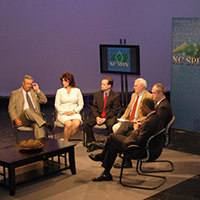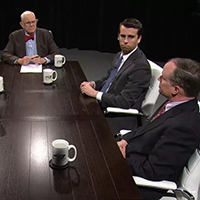What's the end game of the tariff war?
Published April 10, 2025
(Editor's note: This column was submitted before Wednesday's pause on tariffs. We thought the contents were still worth sharing)
As I write this column, the Trump Administration has levied new higher tariffs on most countries. The business community is not happy, as reflected in several large drops in the stock market.
Before getting deep into today’s column, let me give a reminder of what a tariff is. A tariff is a fee – some call it a tax – on imported products levied by the federal government. For example, if $1000 worth of toys are imported to the US from China, and the US tariff rate is 25%, then 25% of $1000, or $250, is paid to the US government in a tariff. And who pays this $250? It is the US company importing the toys, not the exporting company in China. Furthermore, economic studies have shown companies paying more tariffs will often pass a significant part of the tariff on to buyers of the product. Or, some part of the tariff could be effectively paid by the company through cutting employment or other costs.
If domestic consumers, business, and potentially workers are hurt by higher tariffs, why have they been implemented? What are the goals of the tariffs, and can they be reached? These are questions I try to answer in this column, and then let you decide if the goals of tariffs justify the means of using them.
The Trump Administration has talked about three goals from using higher tariffs. One is to motivate an expansion of domestic manufacturing by making foreign-manufactured products more expensive. As a percentage of the economy, domestic manufacturing has declined for several decades. We’ve seen the same trend in North Carolina.
A second goal is to reduce the annual trade deficit in products. For several decades, each year the US imports more goods from other countries than we sell to those countries. The result is called a trade deficit. The Trump Administration would like to decrease this deficit, or even turn it into a surplus.
The third goal is to have tariffs used by foreign countries to be more in line with US tariffs. Traditionally, the US has had some of the lowest tariffs in the world, at the low single digit level. Many other countries we trade with have double-digit tariffs. This situation puts the US at a disadvantage when trying to sell products in those countries.
Notice that the first and third goals are likely incompatible, at least for a time. The first goal depends on keeping tariffs high so as to provide maximum incentives for US manufacturing to expand. Yet the third goal has the objective of lowering both foreign and domestic tariffs. At some point the Administration will have to choose between the first and third goals. The second goal of reducing the trade deficit will occur with both the first and third goals.
Let’s look at the likely process of achieving these goals, beginning with the third goal of reducing foreign countries’ tariffs. This could be accomplished through negotiations. Since the US has the largest economy in the world, foreign countries are eager to trade with us, and high tariffs make it hard for them to sell their products in the US. Hence, there is a direct pathway for negotiation. Low tariffs by all countries, including the US, would put the competition for buying and selling products between the US and other countries on a much more level playing field.
If the third goal is accomplished, the second goal of reducing the US foreign trade deficit would follow. Since before the tariff war the US had much lower tariffs than other countries, reducing tariffs worldwide would help our country much more in selling products to other countries, with the result being a lower, or maybe no, trade deficit.
The first goal of expanding domestic manufacturing to take the place of foreign-made manufactured products is likely the hardest to achieve for several reasons. Number one, it would require a large number of new factories to be built in our country, and the construction would require years. Would the high tariffs remain until the factories were constructed? If “yes,” higher prices from foreign made products due to the tariffs would also last for years. What would this do to the standard of living of US consumers?
The second issue is labor for the new factories. There already is a significant labor shortage for manufacturing jobs in the country, including in North Carolina. What would be the source for the workers needed for the new factories?
The third issue is the question of specialization versus self-sufficiency. Like people, countries tend not to be totally self-sufficient. Instead, countries specialize in making certain products where they have the proficiency and resources, and often this specialization changes over time. For example, for much of the 20the century, making tobacco products, textiles, apparel, and furniture were major industries in North Carolina. Health issues caused the tobacco industry to shrink, but making textiles, apparel, and furniture moved to other countries with much lower cost labor. But today, North Carolina has new specializations in pharmaceuticals, technology, aeronautics, finance, and other sectors, with many of the jobs being very high paying. Fortunately, we’re now seeing some of these industries locate in the regions that lost tobacco, textiles, apparel, and furniture jobs.
There is another question related to the current debate over trade and specialization. Are there some products the country should make, even if other countries could manufacture the products better and cheaper? Many say the answer is “yes,” particularly for products like steel and aluminum related to making military equipment, as well as some medical products. These are often called “essential products.” This issue is also part of the tariff debate.
The current “tariff war” is a big deal. At stake are international relations between countries, the prices consumers pay, and the health of the economy, including investments. Three goals appear to be behind the tariff war. Which goal will receive priority, and when will we know when success has been achieved? In short, what is the end game? You decide.
Walden is a Reynolds Distinguished Professor Emeritus at North Carolina State University.







